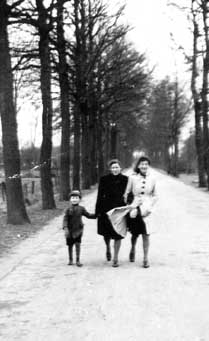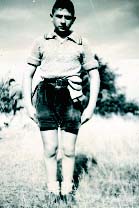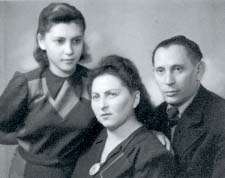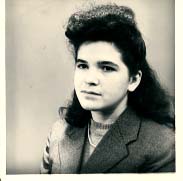| |
 In
Pursuit of Terrible Truths In
Pursuit of Terrible Truths
Close to Home-New volume gathers Vermonter's
personal accounts of Holocaust
After
two days of listening to rather dry presentations at a scholarly colloquium,
filmmaker Claude Lanzmann had begun to despair about finding an authoritative,
commanding voice for Shoah, his documentary of the Holocaust.
Then Raul Hilberg took the podium.
“He
stood out against the others: by what he said; by his voice, metallic
and warm; by the way he carried his body,” Lanzmann would later write.
“His body itself spoke. Hilberg literally embodied and accepted the
essential dare that the Holocaust makes to all who seek to bring it back
to life.”
Hilberg,
who retired from teaching at the university in 1991, built a near-legendary
academic career by accepting that essential dare. He was a young UVM professor
in 1961 when he published his landmark volume, The Destruction of the
European Jews, a foundational piece of research that documented the Holocaust,
brought it “back to life” with a rigor and authenticity never
before approached.
The
door was opened, and for the next three decades, Hilberg would continue
to pursue his research and teaching at the University of Vermont with
an authority and a passion that would make an indelible impression on
his faculty colleagues, the world’s foremost Holocaust scholars,
and some ten thousand UVM students fortunate enough to enroll in one of
his classes.
And
many of those students are still learning from the venerable professor.
One evening last November, approximately two hundred New York area alumni
ventured to Morgan Stanley Dean Witter headquarters in Manhattan’s
Times Square for another hour in Professor Hilberg’s class. Today’s
lecture: “The Holocaust: Who Knew What When.”
Alumnus
Larry Roth ’67 shook his head when asked what brought him out that
evening. “More than thirty years after sitting in Professor Hilberg’s
class, I still quote him. ‘Know what you’re looking at. Study
it. Never take anything at face value.’” Roth brought his son’s
favorite high school teacher as a guest, reasoning that one great teacher
should see another.
In many ways, the New York event was a gathering of generations stitched
together by the common thread of Raul Hilberg and the legacy of Holocaust
study that has continued since his retirement. Before the talk, alumni
from classes that span the past five decades mingled
with current Arts and Sciences faculty — Wolfgang Mieder, Alan Wertheimer,
Jonathan Huener, David Scrase — who have helped to keep Holocaust
studies vital at UVM.
Jerry Jacobson ’62 and Evan Scheuer ’80 were among the alumni
at the event with stories of the memorable challenge of Hilberg’s
classes — the spellbinding lectures and rigorous tests that made
a lasting impression. When an effort was mounted to honor Hilberg at his
1991 retirement, it was alumni memories such as these that inspired the
support to create a Holocaust symposium at UVM celebrating the professor’s
career and setting the groundwork for continuing his tradition.
The April 1991 event was built on a formula that is the essence of much
of the work of today’s Center for Holocaust Studies — the teaching
and research of UVM faculty inspired by Hilberg’s legacy, the fresh
perspective of visiting scholars, the participation of the Vermont community
beyond the campus, and loyal supporters who have often stepped up to provide
the funding to make programming possible.
For
three days, “The Hilberg Symposium” made UVM the epicenter of
Holocaust studies for the entire world. Leading scholars such as Yehuda
Bauer and Christopher Browning were joined by filmmaker Lanzmann and novelist
Herman Wouk to pay tribute to Hilberg and speak to packed houses in Ira
Allen Chapel.
“A
number of us knew that we had to build on that event,” says Jacobson,
who had kept in touch with Hilberg through the years. He also had reconnected
with UVM’s Political Science Department when his daughter Lisa ’92
was a student. Conversations with one of her favorite professors, Alan
Wertheimer, led to Jacobson’s taking a key role in the Hilberg Symposium.
Reconnecting
with the university as a parent drove one-time UVM student Paul Konigsberg’s
involvement with Holocaust Studies as well. Konigsberg started his college
education at UVM in the 1950s but transferred to New York University two
years before Hilberg came to campus. He was pleased when his son Stephen
closed the circle and chose UVM in the 1980s. Hilberg became one of Stephen
Konigsberg’s most influential professor’s at UVM. That fact,
coupled with Paul Konigsberg’s longstanding support of Jewish issues
and affairs, impelled him to get involved and play a key role in fundraising
for the Hilberg event.
“It’s
essential that people understand this tragedy, and not only from a Jewish
standpoint,” says Konigsberg. “Vermont’s taken an important
role in this, and it’s been very satisfying to see the Holocaust
Center at UVM nurtured from nothing to a program that is vibrant and healthy.”
That program has evolved into a mix of classes across disciplines, public
lectures and symposia, community events such as a gathering for survivor
families, publications, summer classes for Vermont teachers who plan to
teach the Holocaust, and an option for an undergraduate minor.
Wolfgang Mieder, professor of German and a member of the Holocaust Studies
Advisory Board, says he sees balance as one of the great strengths of
UVM’s center. “An academic program like ours should have scholarship
as its foundation in events and publications. We do that well,” Mieder
says, “but we also explore the emotional and personal through narratives
and events like survivors gatherings.”
David
Scrase, director of Holocaust Studies and professor of German, says “It
is especially important for individuals far removed from dire situations
from which we might learn to be exposed to such matters.”
He
mentions that the Jewish population of Vermont, roughly 1 percent, corresponds
to the Jewish population of Germany in 1933. “Vast tracts of Germany
knew nothing of the German Jews firsthand, just as the citizens of the
more rural parts of Vermont may know little of Jewish life in Burlington.”
A
recent major gift from alumnus Leonard Miller ’51 and his wife, Carolyn,
has strengthened the foundation for future Holocaust Studies work at a
time when keeping the lessons of this era fresh grows more challenging
by the day.
“As
the Holocaust becomes history and not the experiences of grandfathers
and grandmothers, we will attempt to keep alive the facts and the experiences
which make up one of the greatest evils perpetrated by humans on other
humans,” Scrase says. “We must also link this event to other
acts of ‘ethnic cleansing’ as they continue to appear —
even in the same Europe that saw the Holocaust. Sometimes, we humans do
not learn very much very well.”
Keeping
the lessons vital, honoring the memory of those whose lives were lost,
giving thanks for the lives that were spared, and assuring that it never
happens again, are ultimately what drive those who pursue and support
Holocaust studies at UVM and elsewhere.
It
is a devotion that comes from both mind and heart. Ask Leonard Miller
what motivates him to support Holocaust Studies and he’ll fix you
with a gaze and tell you about his parents, Russian-born Jews who left
their homeland in 1915, settled in Boston, then Burlington.
“If they hadn’t, I wouldn’t be here,” Miller says.
“That’s my motivation.” VQ
Close
to Home
New
volume gathers Vermonter's personal accounts of Holocaust
The
Holocaust: Personal Accounts, edited by David Scrase and Wolfgang Mieder,
was published in May by UVM’s Center for Holocaust Studies. The volume
brings together twenty first-person narratives from individuals who experienced
the Holocaust. Survivors to liberators, the writers all either live in
Vermont or have been associated with The Center for Holocaust Studies
at UVM. The following are excerpted from the publication.
away
from home: reflections of a child survivor
Yehudi Lindeman
Born in Holland in March 1938, during the week of the German invasion
and occupation of Austria know as the Anschluss, Yehudi Lindeman was four
years old when he went into hiding.
“It was the beginning of an itinerant existence that would take me
to at least fifteen different locations, none of them stable or permanent.
I stayed at several other farms, both poor and prosperous, at a dentist’s
house, a flower shop, a butter factory, the list goes on and on, and I
don’t even remember all of them. The only sense of stability I felt
was when yet another stranger, some young man or woman, (a courier working
for the resistance, no doubt), would take me once again to a new place
of hiding, usually on the back of a bicycle. I recall feeling very safe
during those many nocturnal rides, sitting close to the person in front
of me, the sound of the bicycle’s tires steady and reassuring in
the night. I think they gave me the only sense of faith that I ever had
during those years.”
 growing
up fast in breslau growing
up fast in breslau
Frank Schaal
Frank Schaal was a twelve-year-old school boy in Breslau, Germany when
Hitler came to power.
“Whereas before we had religious instruction, each according to his
own religion, this was canceled. Instead we had an added zoology lesson
called “Rassenkunde” (racial instruction). The students were
to be instructed about the Aryan race, the race Hitler had designated
superior and to which he said Germans belonged. Non-Aryans were all others,
in particular, of course, the Jews. Since there were only two Jews in
the class and the other boy had light brown hair, I was the one pulled
out of his seat and hustled before the class. The teacher, with his black
uniform and his staring, protruding eyes, began to analyze my facial anatomy
in order to explain how to recognize a Jew. Dark brown or black hair,
long protruding nose, broad cheekbones, dark brown or black eyes, and
so on. Pretty soon I had to make my way home by myself.” Right:
Frank Schaal, age 15, last year of high school, 1936.
 we
went on we
went on
Gina Gotfryd
Gotfryd describes arriving at Auschwitz.
“We were soon moved to another large room where other male prisoners
shaved our hair — heads, underarms, and pubic hair. We were then
pushed into a huge shower room. After the showers, where no soap or towels
were given, some kind of raggedy dresses were thrown at us. There was
no underwear, but some old shoes or clogs. The dresses were of the strangest
shapes or forms. Tall women got very short dresses, short women had dresses
down to their ankles, and even though we knew that we had entered the
gates of hell, we looked at each other and laughed.” Top right:
Gina Gotfryd with her parents, one of the few intact nuclear families
to survive the Holocaust
 staying
together staying
together
Aranka Siegal
Siegal describes her final day at Bergen-Belsen.
“Iboya (her sister) and I, through some unexplainable miracle, and
several close calls, lived long enough, if barely, to greet the British
army, our liberators, on 15 April 1945. I had developed a case of dysentery,
from which so many had already died and continued to die even after liberation.
But Iboya dragged me out of the barrack, ran after a medic, and cried,
‘My sister is dying. You must help her.’ She held on to his
arm and wouldn’t let go until he had me put on a stretcher and marked
my forehead with a red cross, an indication for the ambulance that I could
be saved by immediate attention.
As soon as he turned his back, Iboya used some spit to dampen the cross.
She pressed her forehead against mine, copying the cross onto her own
forehead, and lay down beside me. The last thing I heard before I lost
consciousness, after having lost my family, my home, and my childhood
through a torturous year of Hitler’s insane depravity, were Iboya’s
words — ‘They can’t separate us now!’” Aranka
Siegal’s passport photo, age eighteen, a survivor
|


